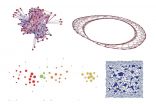(Press-News.org) Patients suffering from the world's most common heart rhythm disorder can have their long-term outcomes significantly improved with an aggressive management of their underlying cardiac risk factors, according to University of Adelaide researchers.
Atrial fibrillation (AF) is increasingly responsible for dementia, stroke and death, and has a significant impact on healthcare costs. With electrical "short circuits" believed to be responsible for the abnormal beating of the heart in AF patients, one currently used treatment is to burn the tissue surrounding the problem area, in a process known as "catheter ablation".
A study in the University of Adelaide's Centre for Heart Rhythm Disorders followed more than 149 AF patients who had undergone catheter ablation. Of these, 61 had also undergone an intensive risk factor management program.
The program involved attending follow-up appointments at a dedicated risk factor management clinic every three months, in addition to the patients' normal specialist appointments. Risk factors addressed in the program included weight, blood pressure, blood sugar levels, and cholesterol, as well as addressing sleep breathing problems, and smoking and alcohol.
The findings, published in this month's issue of the Journal of the American College of Cardiology, conclusively show that patients who managed their lifestyle factors were five times more likely to have long-term survival without any further heart arrhythmia.
"After a period of five years, arrhythmia-free survival rates for patients who undertook the risk management program were 87%, compared with less than 18% of the control group," says the study's lead author, Dr Rajeev Pathak, a Cardiologist and Electrophysiology Fellow with the University of Adelaide, the Royal Adelaide Hospital and the South Australian Health and Medical Research Institute (SAHMRI).
"This is a very important finding because it shows the huge gap between what happens when patients are able to manage the underlying risks of their health and those who rely solely on medical intervention," he says.
"It highlights the difference between simply being reactive to the health problem, and being responsive by changing lifestyle and trying to do something about those underlying risks.
"Our results help to reinforce a significant public health message about lifestyle, and they show what a targeted management program can achieve," Dr Pathak says.
"This study should serve as a wake up call to physicians to begin prevention programs to reduce disease states rather than focus on their treatment only, and the good news is: it is never too late to start."
INFORMATION:
This research has been supported by the National Health and Medical Research Council (NHMRC) and the National Heart Foundation of Australia.
Media Contact:
Dr Rajeev Pathak
Cardiologist and Electrophysiology Fellow
Centre for Heart Rhythm Disorders
The University of Adelaide
rajeev.pathak@adelaide.edu.au
Mammals that lived during the time of the dinosaurs are often portrayed as innocuous, small-bodied creatures, scurrying under the feet of the huge reptiles. In reality, this wasn't the case, and a new fossil from Madagascar further underscores this point, revealing fascinating perspectives on the growing diversity of Mesozoic mammals. Vintana sertich had previously been described in a preliminary note in November of this year, but a new memoir in the Journal of Vertebrate Paleontology delves far deeper into the morphology and paleoecology of this amazing fossil animal. ...
A simple supplement could be a safe and cost-effective way of reducing heart disease in individuals born with a low birth weight, suggests research from the University of Cambridge. The study, carried out in rats, also raises the possibility of developing a blood test to indicate how much damage there is in the aortas of these individuals.
Researchers at the Institute of Metabolic Science fed low birth weight rats a supplement of the molecule co-enzyme Q (CoQ) and found that in those rats that grew quickly after birth, the supplement prevented cells in the aorta from ...
Techniques now used to reconstruct 3D models based on multiple photos of a building, object or scene can also be leveraged to automatically estimate illumination conditions depicted in a collection of photographs, scientists at Disney Research and Université Laval report.
Everyone knows that objects can look markedly different depending on lighting conditions, the physical characteristics of the objects and the angle at which they are viewed. That makes it difficult for photo editors to insert 3D objects into imagery and make them appear as if they are reflecting ...
The Taj Mahal's iconic marble dome and soaring minarets require regular cleaning to maintain their dazzling appearance, and scientists now know why. Researchers from the United States and India are pointing the finger at airborne carbon particles and dust for giving the gleaming white landmark a brownish cast.
Knowing the culprits in the discoloration is just the first step in cleaning up the Taj Mahal. Scientists now must determine where the particles are coming from to develop strategies for controlling them.
"Our team was able to show that the pollutants discoloring ...
New York, NY, December 9, 2014 - Fourteen years after the attack on the World Trade Center (WTC), a case study in the current issue of Annals of Global Health identifies several elements that have had a critical impact on the evolution of the WTC response and, directly or indirectly, on the health of the WTC-exposed population. The case study also recounts and assesses post-disaster monitoring efforts, recent scientific findings from the World Trade Center Health Program (WTCHP), and explores the implications of these experiences for ongoing and future environmental disaster ...
The global spread of Ebola is due to the complex interactions between individuals, societies, and transportation and trade networks. Understanding and building appropriate statistical and mathematical models of these interactions is vital to responding to the challenges of living in a networked world. There are, of course, many other examples of complex networks -- from national power grids and airline networks to social networks, neuronal networks and protein-protein interactions.
In a new study published in the Beijing-headquartered journal National Science Review, ...
This news release is available in Japanese.
New research published in the Proceedings of The Royal Society A by members of the Mathematical Soft Matter Unit at the Okinawa Institute of Science and Technology Graduate University examines the energies at work in a closed flexible loop spanned by a soap film. While the underlying experiments are simple enough to be replicated in a kitchen sink, the research generates potentially important questions and changes how we think about different disciplines from material science to vertebrate morphogenesis. Aisa Biria and Professor ...
UNIVERSITY OF CALIFORNIA, BERKELEY'S HAAS SCHOOL OF BUSINESS -Too many vehicles on the highway inevitably slow down traffic. On the Internet information highway, consumers value high-speed Internet service, but there is little reason to think broadband traffic congestion will improve if the Federal Communications Commission abandons net neutrality, according to economic research.
In their paper, "The Economics of Network Neutrality," Ben Hermalin, Haas Economics Analysis and Policy Group, and Nicholas Economides, Berkeley-Haas visiting professor from NYU'S Stern School ...
Scientists at the University of Strathclyde and City University of New York have created methods that dramatically simplify the discovery of biological gels for food, cosmetics and biomedicine, as published in the journal Nature Chemistry.
Strathclyde's Dr Tell Tuttle and Professor Rein Ulijn, the director of nanoscience at City University New York's new advanced research centre who also holds a position at Strathclyde, believe their team's breakthrough dramatically simplifies discovery of functional gels that can be used in a wide range of applications.
Until now, ...
The drug daclatasvir (trade name Daklinza) has been available since August 2014 for the treatment of adults with chronic hepatitis C (CHC) infection. The German Institute for Quality and Efficiency in Health Care (IQWiG) examined in a dossier assessment whether this new drug offers an added benefit over the appropriate comparator therapy.
The drug manufacturer presented data for patients without cirrhosis of the liver who are infected with hepatitis C virus (HCV) genotype 1, and for patients with HCV genotype 4. However, these data are unsuitable in various aspects to ...




